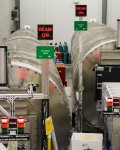Solar cells that convert sunlight into electricity have potential to be a widely used renewable energy source. Getting to that point, though, requires breakthroughs in their cost and their efficiency at turning sunbeams into electric current. Neutron scattering experiments conducted at Oak Ridge National Laboratory (ORNL) are helping solar cell makers obtain the hard data they need to refine their materials and manufacturing processes.
One of the most promising options for lowering costs is to fabricate organic solar cells by depositing polymer-based thin films on flexible substrates. These devices are easy to produce in large volumes because they use conventional polymer processing methods, which are relatively cheap and energy-efficient compared with manufacturing silicon solar cells. Also, panels made from organic solar cells are lighter and less expensive to install than the bulky solar panels most often used now.
The drawback to these easily fabricated thin-film devices is their power conversion efficiency—how well they convert solar radiation to electricity. They’re much less efficient than silicon cells (which are approaching 30% efficiency). To be financially viable, they must reach a conversion efficiency of more than 10%, but the most highly rated ones developed to date rate only ~8.3%. To get to the necessary efficiency, scientists need to understand the molecular structure of the films, how it relates to device efficiency, and how to tailor it for the greatest efficiency.
Recent studies of polymer-based solar cells at ORNL’s Spallation Neutron Source and High Flux Isotope Reactor revealed important details about their molecular structure and how annealing (heat treating) the devices substantially improves their power conversion efficiency. The experiments showed that annealing solar cells appropriately during fabrication improves the conversion efficiency by more than 20% compared with the film as deposited.
“We are trying to use mixtures of photoactive polymers to absorb light over a broad wavelength range to improve efficiency,” said principal investigator Thomas Russell of University of Massachusetts–Amherst. Haiyun Lu of the University of Massachusetts and Bulent Akgun of the NIST Center for Neutron Research and the University of Maryland are co-investigators. Studies such as this one are key to improving the performance of polymer-based solar cells, making mass production and widespread use feasible.
The device studied was a bulk heterojunction (BHJ) solar cell, meaning it consists of two semiconductors that have a large area of interface with each other. The semiconductors used in this study were the polymer PSBTBT and PCBM, a carbon compound that is widely used in organic solar cells. The blend was used as a model for understanding the active layer of an actual solar device (i.e., the layer that actually traps and transports the solar energy). BHJ solar cells contain one material that donates electrons (PCBM, in this case) and one that accepts them (PSBTBT). The exchange of electrons between these two materials produces the electrical current.
The characterization effort, which included x ray probes and electron microscopy as well as neutron scattering, examined thin films of PSBTBT : PCBM deposited onto a silicon substrate. The films were examined in their original state and then after annealing done either before an aluminum electrode was deposited (pre-annealing) or after (post-annealing). The penetration power of neutron scattering enabled a systematic, detailed in situ investigation of the structure of the active layer of the BHJ devices and the nature of the PSBTBT/ PCBM interfaces, and their interfaces with the substrate, under the different processing conditions.
The MAGICS magnetism reflectometer at SNS investigated the vertical arrangement of the layers deposited on the substrate, and the General Purpose Small-Angle Neutron Scattering instrument at HFIR characterized the uniformity of the PSBTBT /PCBM distribution and the degree of mixing in the horizontal plane of the film.
“Structural characterization of thin films has always represented a challenge for small-angle neutron scattering,” noted Yuri Melnichenko, lead scientist at GP SANS. Monitoring the subtle structural changes caused by changing conditions during film formation requires the highest available neutron flux to increase the signal-to-noise ratio, and HFIR provides one of the highest-flux cold neutron beams for SANS in the world.
“Scattering was measured within approximately 24 hours, while similar measurements at less intense neutron sources would require 5–7 days of the beam time to get similar statistics,” Melnichenko said.
“The high contrast between PCBM and PSBTBT and the spatial resolution of 0.5 nm makes neutron reflectometry a key method for studying the structure and distribution of components normal to the surface of the film,” said Valeria Lauter, lead scientist for MAGICS. “The measurements of the as-spun, pre-annealed, and post-annealed films made it possible to trace the details of the changes in the depth profiles of the films.” The NR measurements showed that diffusion and intermixing of the PCBM into the PSBTBT layer increased steadily as the sample was annealed up to 1 minute. As heating continued beyond 1 minute, the diffusion changed little, indicating saturation of PCBM.
The experiments determined that annealing the cell at 150°C for 1 minute after the electrode was inserted improved the cell’s power conversion efficiency by slightly over 20% compared with the original coating. Post-annealing for shorter times improved efficiency by lesser amounts, and annealing for times longer than 1 minute caused it to decline. Pre-annealing reduced the efficiency, compared with the original coating, by almost as much as post-annealing increased it.
The research was funded by the U.S. Department of Energy Office of Basic Energy Science and DOE’s Energy Frontier Research Center on Polymer-Based Materials for Harvesting Solar Energy at the University of Massachusetts–Amherst. Konarka Technologies also provided materials and financial support.
Published Work
Haiyun Lu, Bulent Akgun, and Thomas P. Russell, “Morphological characterization of low-bandgap crystalline polymer: PCBM bulk heterojunction solar cells,” Advanced Energy Materials, (2011): DOE:10.1002/aenm.201100128.








